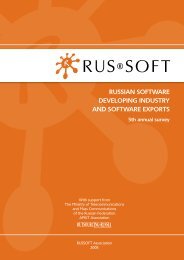russian software developing industry and software exports
russian software developing industry and software exports
russian software developing industry and software exports
Create successful ePaper yourself
Turn your PDF publications into a flip-book with our unique Google optimized e-Paper software.
Chapter 2.<br />
Volume <strong>and</strong> Structure of Russian Software Export<br />
The total revenue of all Russian companies from<br />
sales of <strong>software</strong> products, <strong>software</strong> development<br />
services, implementation <strong>and</strong> maintenance of<br />
information systems (including revenues of their<br />
international development centers) amounts to<br />
approximately USD 5.5 bn at the year-end 2008.<br />
In 2008, the volume of <strong>software</strong> export increased<br />
by 21% <strong>and</strong> made USD 2.65 bn. This was the smallest<br />
growth in the whole history of the survey. Since 2003<br />
this indicator never dropped lower than 28%. The<br />
Compound Annual Growth Rate (CAGR) of <strong>software</strong><br />
sales by Russian companies abroad in the period from<br />
2002 till 2007 was 44.3%.<br />
Obviously, the slowdown in the growth rate was<br />
caused by the crisis. According to the most optimistic<br />
estimates, in 2009 <strong>software</strong> export will not increase<br />
more than by 10%. It is not impossible that there<br />
would be no export growth whatsoever.<br />
On the basis of respondents’ expectations the poll<br />
allows to make a forecast for 2010. The companies<br />
hope for the improvement of the market situation <strong>and</strong><br />
for the average growth by 18%. However, it becomes<br />
difficult to make forecasts based on anticipations<br />
changing every month.<br />
Before the global crisis forecasts based on<br />
evaluations of company executives enabled to make<br />
quite accurate predictions that differed from the<br />
final result maximum by 10% in either direction. Such<br />
deviations are quite acceptable given the complexity<br />
of forecasting. Anyway, we could speak of the<br />
sustainable growth in the foreseeable future, <strong>and</strong> this<br />
prediction would always come true.<br />
The 2008 results have shown that in the situation<br />
of the crisis the prediction method based on company<br />
expectations brings incorrect results. Instead of the<br />
forecast export volume of USD 3.35 bn <strong>and</strong> growth<br />
by 52% final figures were only USD 2.65 bn <strong>and</strong> 21%,<br />
respectively. The growth of <strong>exports</strong> by 21% looks<br />
quite substantial, but only for the economies with<br />
a developed IT <strong>industry</strong>. To realize its potential in<br />
the field Russia should grow by 30-50% at least for<br />
several years.<br />
At the moment it is difficult to underst<strong>and</strong> all<br />
reasons of a reduced growth rate. Certainly, the<br />
impact of the crisis cannot be denied, however in<br />
2008 <strong>software</strong> export could be affected by other<br />
factors, too.<br />
Due to the duration of the current projects the<br />
crisis hit the revenues of Russia service companies<br />
closer to the year-end. The world market of readymade<br />
solutions <strong>and</strong> products also started to decline in<br />
late 2008. Therefore, the growth rate reduction from<br />
the expected 52% to 21% is unlikely to be caused by<br />
the crisis alone.<br />
It should be noted, that in 2007-2008 several<br />
major service companies ceased to see any prospects<br />
in the expansion of their offices <strong>and</strong> establishment<br />
of new development centers in Russia. The Russian<br />
labor market faced problems in finding sufficient<br />
numbers of specialists to maintain the growth rate at<br />
the same level. If salaries had to be further increased,<br />
developers would have become uncompetitive in<br />
the global market of <strong>software</strong> development. That is<br />
why such companies as Luxoft <strong>and</strong> Exigen Services<br />
opened their development centers in South-East Asia<br />
(in Vietnam <strong>and</strong> China, respectively).<br />
In future production sites in Asia can become<br />
a source for significant growth of certain companies.<br />
At the same time, at the initial stage it is planned<br />
to increase the staff carefully following the<br />
synchronization of works of teams located in different<br />
parts of the world in different cultural environments.<br />
Nevertheless, Russian companies need to globalize<br />
<strong>and</strong>, therefore, be represented in all important labor<br />
markets of the world.<br />
The growth of foreign development centers<br />
will require training of a big number of qualified<br />
specialists able to participate in international projects.<br />
In the coming years changes in the education system,<br />
employment of the population, tax legislations <strong>and</strong> a<br />
more substantial state support of the <strong>industry</strong> in other<br />
areas may help to considerably increase the inflow to<br />
the Russian market of developers with qualifications<br />
<strong>and</strong> costs that would satisfy export companies.<br />
Russian programmers are still earning at least<br />
2-3 times less than their colleagues in the USA <strong>and</strong><br />
Western Europe. But Russian export companies<br />
have other expense items that make this competitive<br />
advantage less significant. Moreover, they compete<br />
mainly with companies from the countries where<br />
the level of payment, tax burden <strong>and</strong> lease costs are<br />
much lower than in Russia.<br />
Due to the crisis staff costs <strong>and</strong> costs on office<br />
lease in Russia have considerably decreased. This<br />
has already positively influenced the growth of<br />
<strong>software</strong> companies, <strong>and</strong> if these costs remain at such<br />
levels, we can expect that the positions of Russian<br />
companies in the global market of IT services would<br />
also maintain. But if the State raises taxes, then all the<br />
benefits obtained owing to the crisis will immediately<br />
disappear.<br />
The impact of the staff issue on the reduction of<br />
export growth rate is also proved by the discontinued<br />
mass transfer of employees from small companies to<br />
larger enterprises. The share of dismissed staff in small<br />
<strong>and</strong> larger companies is almost the same. Experts <strong>and</strong><br />
company executives started to speak of the staff issue<br />
as a threat to future growth of the <strong>industry</strong> already<br />
long ago. Nevertheless, during the market growth<br />
the number of specialists involved in the <strong>software</strong><br />
sector was constantly growing (partially owing to<br />
employees moving to Russia from the neighbor<br />
states). Software export was also booming. All that<br />
created an illusion of absolute prosperity for Russian<br />
officials. They forecast export volumes for many years<br />
ahead proceeding from the current growth rate<br />
thus reporting on the actual state of affairs in the<br />
supervised <strong>industry</strong>.<br />
It should be taken into consideration that export<br />
growth decreased more than total <strong>software</strong> <strong>exports</strong>.<br />
19








